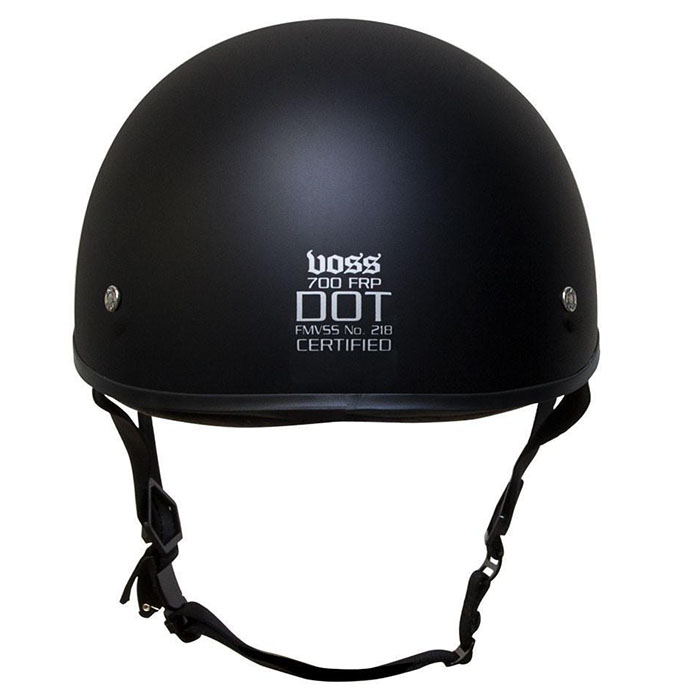So a week or so ago, I was attempting to sneak away from the desk and the computer after my second cup of coffee that morning and The Boss emailed me.
“Bikers’ Den has partnered with Voss Helmets, so can you work some helmet stuff into the new blogs?”
Now, I’ll be honest, since I bought a new lid last year, I don’t think I’ve even thought about helmets except to drop one absentmindedly onto my head before I turn the bike over, but I shot back an email that I’d check them out and cruise around online to see what I could find.
What I found impressed me. Not only was Voss building DOT-certified stuff, they were building stuff that looked good. Over the years, I’ve had countless helmets – from full-face stuff (don’t ask) to some Easy Rider-esque Open Face 3/4s, but, like most of us, I’ve pretty much settled on half helmets. They feel good (if you cinch them down right), they don’t wear you out on a long ride, and – admittedly – they are the most popular thing for V-twin riders these days.
Vanity? Sure, there’s some of that, but I like the look. 25 years ago, we were all wearing full face stuff, but times changed. I like what Voss is putting out on the market and I really like the customer service that I’ve been reading about. They take care of the men and women who ride with their gear.
All that got me to thinking, though, and with the power of Google (and another cup of coffee), I spent some time reading about helmet safety standards. Most of us know that helmets have a shelf life of about 3-5 years, but with the rise of novelty helmets, what should you look for in a new lid?
Simple – one sticker: DOT FMVSS No. 218 Certified…
It has to be on the back of your helmet and that sticker has to be from the manufacturer, not the guy at the swap meet selling these for a buck. Why?
It’s your brain, jackass.
Now, it’s no lie that where I live is within an hour’s ride of two states with no helmet laws (Florida and South Carolina) and, as a younger man who was bulletproof, I have ridden without any cover before. At the same time, going “topless” is a rush, but, like driving in bad weather or trying to beat a thunderstorm, I always had the feeling that I was on borrowed time. Having caught enough bugs in my teeth and a few birds with my chest, all I remember thinking about was if I took the early bird to the head while riding, I was going straight from the asphalt to the Motorcycle Memorial.
But trying to cut through the crap of understanding DOT standards, Snell testing, and the rather bizarre alternate standards that the Europeans have cooked up left me more confused than ever, and my primary takeaway from all that Googling I did was this:
Buy from a reputable North American dealer, make sure your lid has the correct DOT sticker, and make sure that the manufacture date on your helmet is less than five years ago.
The real irony is that despite the revolutions that have taken place in manufacturing and technology, helmets haven’t really changed a lot since the first laws were put on the books in 1968. You’ve still got a fiberglass or carbon-fiber casing that has varying degrees of Styrofoam wrapped in some sort of fabric that (hopefully) wicks moisture away from your head and (hopefully) can be cleaned.
By the way, THAT’S the main reason for the “five year” rule – sweat, body oils, petroleum fumes, and other funky compounds degrade the lining and the Styrofoam “crush zone” inside the helmet and it cannot protect you as it should.
How do you know that your helmet isn’t safe anymore? Well, first of all, there’s the manufacture date. If your lid doesn’t have one, then chances are, it was made by authentic slave laborers in an offshore sweat shop and the quality was suspect. If you can find the date, that’s a good start – it may not be a novelty helmet.
Now, put it on and strap it down. Can you move it around on your head? If you can deflect it more than an inch or so from side to side or vertically, then your liner is probably degraded to the point where it isn’t offering much protection in the event of a lay down. See, what’s interesting isn’t that the liner degrades, it’s that the liner is really the thing that is going to save your bacon in a crash. It’s there to deflect some of the force of an impact.
Next, there’s the age-old “rumor” about dropping a helmet. It’s not a rumor. Don’t drop your helmet. Period. If you do, you are taking some of the hit out of it that you need to be reserving for your safety. Here’s how this works: Your helmet is designed and tested to take one big bang, then be replaced. UV light gradually breaks down the fiberglass or the carbon fiber (over many years), but careless handling can create stress cracks in a helmet that can lead to a catastrophic failure in a crash event.
So don’t drop your helmet, keep it clean inside and out, and if you don’t know how old it is, or you don’t know the full history of the lid, buy a new one. Shameless plug here? You guessed it – check out the new Voss Helmets page at The Bikers’ Den.


